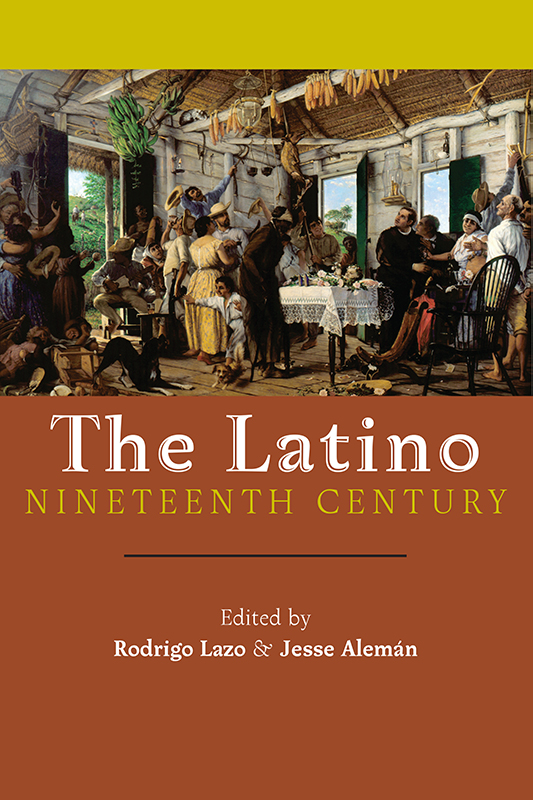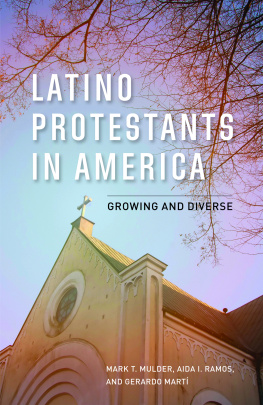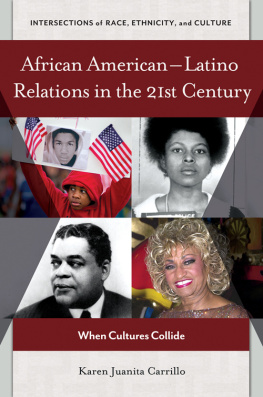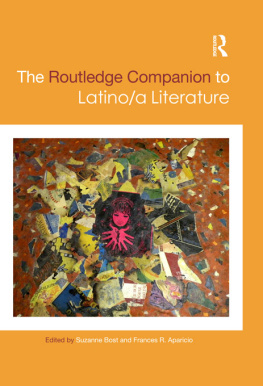
The Latino Nineteenth Century
AMERICA AND THE LONG 19th CENTURY
General Editors: David Kazanjian, Elizabeth McHenry, and Priscilla Wald
Black Frankenstein: The Making of an American Metaphor
Elizabeth Young
Neither Fugitive nor Free: Atlantic Slavery, Freedom Suits, and the Legal Culture of Travel
Edlie L. Wong
Shadowing the White Mans Burden: U.S. Imperialism and the Problem of the Color Line
Gretchen Murphy
Bodies of Reform: The Rhetoric of Character in Gilded-Age America
James B. Salazar
Empires Proxy: American Literature and U.S. Imperialism in the Philippines
Meg Wesling
Sites Unseen: Architecture, Race, and American Literature
William A. Gleason
Racial Innocence: Performing American Childhood from Slavery to Civil Rights
Robin Bernstein
American Arabesque: Arabs and Islam in the 19th Century Imaginary
Jacob Rama Berman
Racial Indigestion: Eating Bodies in the Nineteenth Century
Kyla Wazana Tompkins
Idle Threats: Men and the Limits of Productivity in Nineteenth-Century America
Andrew Lyndon Knighton
Tomorrows Parties: Sex and the Untimely in Nineteenth-Century America
Peter M. Coviello
Bonds of Citizenship: Law and the Labors of Emancipation
Hoang Gia Phan
The Traumatic Colonel: The Founding Fathers, Slavery, and the Phantasmatic Aaron Burr
Michael J. Drexler and Ed White
Unsettled States: Nineteenth-Century American Literary Studies
Edited by Dana Luciano and Ivy G. Wilson
Sitting in Darkness: Mark Twains Asia and Comparative Racialization
Hsuan L. Hsu
Picture Freedom: Remaking Black Visuality in the Early Nineteenth Century
Jasmine Nichole Cobb
Stella
meric Bergeaud
Translated by Lesley Curtis and Christen Mucher
Racial Reconstruction: Black Inclusion, Chinese Exclusion, and the Fictions of Citizenship
Edlie L. Wong
Ethnology and Empire: Languages, Literature, and the Making of the North American Borderlands
Robert Lawrence Gunn
The Black Radical Tragic: Performance, Aesthetics, and the Unfinished Haitian Revolution
Jeremy Matthew Glick
Undisciplined: Science, Ethnography, and Personhood in the Americas, 18301940
Nihad M. Farooq
The Latino Nineteenth Century
Edited by Rodrigo Lazo and Jesse Alemn
The Latino Nineteenth Century
Edited by Rodrigo Lazo and Jesse Alemn

NEW YORK UNIVERSITY PRESS
New York
NEW YORK UNIVERSITY PRESS
New York
www.nyupress.org
2016 by New York University
All rights reserved
References to Internet websites (URLs) were accurate at the time of writing.
Neither the author nor New York University Press is responsible for URLs that may have expired or changed since the manuscript was prepared.
ISBN : 978-1-4798-9683-7 (hardback)
ISBN : 978-1-4798-5587-2 (paperback)
For Library of Congress Cataloging-in-Publication data, please contact the Library of Congress.
New York University Press books are printed on acid-free paper, and their binding materials are chosen for strength and durability. We strive to use environmentally responsible suppliers and materials to the greatest extent possible in publishing our books.
Manufactured in the United States of America
10 9 8 7 6 5 4 3 2 1
Also available as an ebook
Contents
Jesse Alemn
Rodrigo Lazo
Kirsten Silva Gruesz
Ral Coronado
Emily Garca
Jesse Alemn
Robert McKee Irwin
John Alba Cutler
Jos Aranda
Marissa K. Lpez
Alberto Varon
Carmen E. Lamas
Carrie Tirado Bramen
Gerald E. Poyo
Juan Poblete
Laura Lomas
Nicols Kanellos
Ralph Bauer
Jesse Alemn
Although the chapters in this collection present a lot of new material, the book isnt so much a revision of literary history per se as its a return to the circuits of texts, print cultures, artists, and intellectuals that constitute in real and imaginary ways the Latino nineteenth century. Initially, the volume emerged as a direct response to nineteenth-century American literary studies, which, as early as Stanley Williamss The Spanish Background of American Literature, gestures toward but never quite grasps what were calling the Latino nineteenth century. The gesture implies an understanding that theres always been a greater context for American literaturethe contiguous Americas, shared revolutionary histories, the Spanish language, and, more recently, rapidly changing population demographics. But American literary studies rarely reaches the Latino nineteenth century because American literature tends to uphold an English-only mentality, extending the laws of the land to the layout of literary history.
The following collection of chapters, however, situates U.S. Latino/a as a central literary, historical, and analytical category to foreground the significance and significant presence of Latino/a writers, texts, and readers in nineteenth-century American culture. Until now, many of the Latino/a texts and the lives of those who wrote and read them have suffered the same fate as Manuel Torres, who, as Emily Garcia poignantly explains in her chapter, remains buried in obscurity in the graveyard of Philadelphias St. Marys Catholic Church. In this grim light, the book inherits from Latin American studies and the Recovering the U.S. Hispanic Literary Heritage Project an understanding of the rich, complicated, and complementary histories that connect, divide, and redraw the Americas across literary, linguistic, national, and racial borders, where the term Latino is not, as some might assume, an anachronism but a marker of nineteenth-century transnationality that the following chapters excavate.
The Latino Nineteenth Century begins with an insistence on the legibility of Spanish-language texts that were written overburied, if you willby the logic and practice of an English-only approach to American literary history. Silly, nave, and racist as he might be, Herman Melvilles Amasa Delano has one up on most scholars of nineteenth-century American literature: He knows Spanish. So no matter how culturally critical nineteenth-century American literary studies can be, and theres been some canon-busting work out there, American literature, as a curriculum and field of study, often reproduces the national imaginarys impulse to subsume difference into a homogenizing narrative about Anglophone Americaits young romanticism, free-floating racial guilt, horrifying civil war, and refortification just in time for the reality of modernity, all in English. Yet the writers, writings, and people who populate the Latino/a nineteenth century inhabited a Hispanophone world. Theirs is a world of Spanish-language print culture, circuits, readerships, and routes that, while not at all surprising for nineteenth-century America, prove more difficult to decipher and narrate in the largely Anglophone literary history of the United States. For us, this is the first intervention of the Latino/a nineteenth century: Our work insists on reading Spanish-language texts. No progressive, revisionist project for nineteenth-century American literary studies can get around this issue of language. We need as much fluency as silly Amasa to converse with nineteenth-century America, and even then, we still might misread its cues.
Next page







